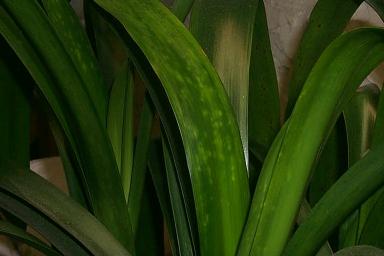
Photo courtesy of Marc Hamel.
Virus-like spots on a clivia leaf.
CliviaNet___________
for clivia lovers around the World
| CliviaNet Home |
| Clivia Overview |
| Cultivation |
| E-Mail and Chat |
| Clivia Society |
| Photo Gallery |
| Seed Exchange |
| Sources |
| Links |
| People |
Clivia diseases can be classified for the most part as either fungal infections or plant virus infections. Clivia can also be attack by a few invertebrate pests.
In their native land of South Africa, Clivia are attacked by the caterpillar of the Amaryllis Borer Moth, Brithys pancratii. which can utterly destroy a plant. In other parts of the world, various general feeding moth larvae can do moderate damage to the foliage or scapes of clivias. In North America, the larvae of the Army Worm Moth are such. Grasshoppers may also do occasional damage, as will snails and slugs.
Outside of South Africa, the most annoying and persistent pest that can attack your clivia may be the mealy bug. These are flightless insects that hide down in the heart of the plant, between the leaves and down toward their bases. Mealy bugs can be almost impossible to eradicate, once an infestation is present. Supeficial spraying of the infected plant with insecticide solutions often proves ineffective. Granular systemic insecticides, added to the soil around the base of the infected plant and watered in lightly, seem to offer the best approach to destroying mealy bugs.
Scale insects are often carried to clivias by ants, which farm the scales for their honeydew exudations. Scale are much easier to control, and spraying with suitable insecticides usually works. The granular systemic materials used to kill mealy bugs are also usually quite effective against scale insects.
Nematodes: not insects but very small, primitive worms about 1 mm long (1/25th inch), transparent and colorless. There are many types of nematodes, some of them beneficial in that they prey on other pests. They are widespread in nature, both good and bad types. Root nematodes can infect clivias, and are almost impossible to get rid of. Heat treatments are used commercially, but the temperaure and the duration of heating must be very closely controlled. A little too little heat and you do not kill the nematodes; a little too much heat and you kill the plant.
It has been suggested that application of granular systemic insecticides early in the growing season can control nematodes. Pesticides specific for nematodes are generally hard to find and can be dangerous to use.
Always check with your local nursery or agricultural authorities about what pesticides are appropriate and legal to use in your situation.
Plant viruses can reach a Clivia plant through an insect or from the hands or unsterile tools of a gardener. A virus infection generally appears as a mottled, spotted, or checkered pattern of light green contrasting to the normal dark green of a healthy clivia leaf.

Photo courtesy of Marc Hamel.
Virus-like spots on a clivia leaf.
Once a clivia plant has been infected with a virus, there is no hope of cure for it. To avoid the potentially catastrophic effects on an entire collection of valuable plants being infected with virus, collectors should immediately remove a virused plant from their collection. It should probably be destroyed and immediately removed entirely from the property housing the collection.
Fungal infections of a clivia are usually due to the plant having been subjected to temperatures that are too cool and to excessive, heavy rainfall. There are many very useful systemic fungicides available for treating plants. You need to consult someone in your own country for advice, since the exact materials that are locally available can vary from one country to another.
For a fungal disease in a clivia plant, physically removing the bulk of the infected plant parts and then spraying with appropriate fungicides should effect an eventual total recovery by the plant. Always maintain good hygiene around valuable plants. Wash your hads before handling healthy plants after you have worked with a sick plant. Sterilize your tools after using them around diseased plants. Protect your investments in time, money and your own energy by following such procedures rigorously.
Because conditions and regulations vary so widely around the world, you will need to consult local experts or your governmental agricultural authorities about how to treat specific maladies of your clivias.
There is more useful information in the book, Clivias, by Harold Koopowitz, Timber Press, Portland (2002). Strangely, I found very little on clivia and nothing on their diseases or pests in The Physiology of Flower Bulbs by A.A. de Hertogh and M. Le Nard, Elsevier, Amsterdam (1993).